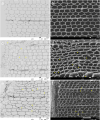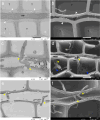Micromorphological features of brown rotted wood revealed by broad argon ion beam milling
- PMID: 39738786
- PMCID: PMC11686018
- DOI: 10.1038/s41598-024-83578-y
Micromorphological features of brown rotted wood revealed by broad argon ion beam milling
Abstract
Brown rot fungi, the major decomposers in the boreal coniferous forests, cause a unique wood decay pattern but many aspects of brown rot decay mechanisms remain unclear. In this study, decayed wood samples were prepared by cultivation of the brown rot fungi Gloeophyllum trabeum and Coniophora puteana on Japanese coniferous wood of Cryptomeria japonica, and the cutting planes were prepared using broad ion beam (BIB) milling, which enables observation of intact wood, in addition to traditional microtome sections. Samples were observed using field-emission SEM revealing that areas inside the end walls of ray parenchyma cells were the first to be degraded. Osmium reaction precipitates were observed in the degraded regions, as well as in plasmodesmata. In the cell wall where ray parenchyma cells contacted with the tracheids, specific degradation of cross-field pits and hyphal elongation into this area was observed in degradation by both fungi. Other pit types were also degraded as noted in previous studies. Delamination between the S1 and S2 layers of tracheids, and cracks in the tracheid cell walls were observed. These findings provide new insights into the cell wall degradation mechanisms during the incipient stages of brown rot decay.
Keywords: Broad ion beam milling; Brown rot fungi; Ray parenchyma cells; Tracheids; Wood degradation.
© 2024. The Author(s).
Conflict of interest statement
Declarations. Competing interests: The authors declare no competing interests.
Figures





References
-
- Highley, T. L. Changes in chemical components of hardwood and softwood by brown-rot fungi. Mater. Organ.22, 39–46 (1987).
-
- Kirk, T. K. & Highley, T. L. Quantitative changes in structural components of conifer woods during decay by white- and brown-rot fungi. Phytopathology63, 1338–1342 (1973).
-
- Kaffenberger, J. T. & Schilling, J. S. Comparing lignocellulose physiochemistry after decomposition by brown rot fungi with distinct evolutionary origins. Environ. Microbiol.17, 4885–4897 (2015). - PubMed
-
- Winandy, J. E. & Morrell, J. J. Relationship between incipient decay, strength, and chemical composition of Douglas-fir heartwood. Wood Fiber Sci.25, 278–288 (1993).
Publication types
MeSH terms
Substances
Grants and funding
LinkOut - more resources
Full Text Sources

